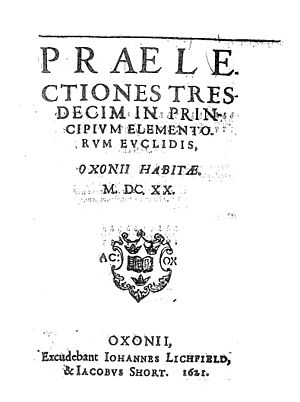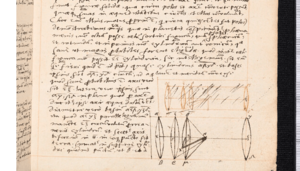Henry Savile (Bible translator) facts for kids

Sir Henry Savile (born November 30, 1549 – died February 19, 1622) was an important English scholar and mathematician. He held important jobs like being the head (called a Warden) of Merton College, Oxford, and the leader (called a Provost) of Eton College. Sir Henry Savile is famous for setting up two special teaching positions, or "chairs," at Oxford University. These were for Astronomy and Geometry, and they are still named after him today. He also helped translate the New Testament from Greek into English for the King James Bible. He was even a member of the Parliament of England, representing areas like Bossiney and Dunwich.
Contents
Sir Henry Savile's Early Life
Sir Henry Savile was born in England, near Halifax, West Yorkshire. His father was also named Henry Savile, and his family was well-known in the area. His mother was Elizabeth Ramsden.
Henry Savile started studying at Brasenose College, Oxford in 1561. Later, in 1565, he became a Fellow at Merton College. He quickly became known as a brilliant scholar in Greek and mathematics. He gave lectures on Ptolemy's famous book, Almagest. In 1575, he became a Junior Proctor at the university.
Travels and Royal Connections
In 1578, Savile traveled around Europe. He collected many old manuscripts during his trips. People say that Queen Elizabeth I even used him as her representative in the Low Countries (modern-day Netherlands and Belgium). When he came back to England, he was chosen to teach Greek to the Queen herself.
In 1583, a powerful leader named Lord Burghley asked Savile to join a special group. This group, which included John Chamber and Thomas Digges, had to decide if England should start using the new Gregorian calendar.
Leading Merton College and Parliament
In 1585, Sir Henry Savile became the Warden of Merton College. He was a very strong leader, even though some students and Fellows didn't always like his strict style. However, under his leadership, the college did very well.
He also translated four books of the Histories of Tacitus, a famous Roman writer. He added his own detailed Commentary on Roman Warfare in 1591, which made him even more respected. Savile also served in Parliament. He represented Bossiney in 1589 and Dunwich in 1593. These areas were known as "rotten boroughs," meaning they had very few voters but still sent members to Parliament.
Provost of Eton College and Knighthood
On May 26, 1596, Savile became the Provost of Eton College. He had worked hard to get this position. He wasn't officially qualified because he wasn't a priest, and the Queen was hesitant. But Savile argued that the Queen could make exceptions, and he eventually got the job.
In February 1601, he was briefly arrested. This was because people thought he might have been involved with a rebellion led by the Earl of Essex. However, he was soon set free. His connections helped him gain favor with King James I. His older brother, Sir John Savile, was also a respected lawyer, which likely helped Henry.
On September 30, 1604, Sir Henry Savile was made a knight. In the same year, he was chosen to be part of the group of scholars who created the Authorised Version of the Bible. He was responsible for translating parts of the Gospels, the Acts of the Apostles, and the Book of Revelation.
Founding the Savilian Chairs
In 1619, Sir Henry Savile used his own money to create and support two new teaching positions at Oxford University. These were the Savilian Chair of Astronomy and the Savilian Chair of Geometry. These important roles are still active today.
He passed away at Eton on February 19, 1622, and is buried there. There is a beautiful monument to him in Merton College Chapel. It shows scenes from Merton and Eton and mentions his important writings.
Sir Henry Savile's Major Works
In 1596, Savile published the first printed version of the first four books of the Gesta Pontificum Anglorum. This was an old church history of England written in the 12th century by William of Malmesbury.
One of his biggest projects was editing the works of St. John Chrysostom, an important early Christian writer. This huge collection filled eight large books and was published between 1610 and 1613. Savile even set up his own printing press and brought in special typefaces for this work. It cost him a lot of money, about £8,000, which was a huge sum back then. This was one of the most significant scholarly works done in England at that time. To complete it, he sent young researchers to famous libraries in places like Vienna and Heybeliada (then part of the Ottoman Empire). He also published an edition of the Cyropaedia in 1618.
Savile was very eager to teach mathematics to his students at Oxford. When he created the Geometry chair, he gave thirteen special lectures in 1620. These lectures were about the first books of Euclid's Elements, a foundational text in geometry. These lectures were published in 1621. Savile was also the first to identify Theon of Alexandria as an important commentator on Euclid's work.
Sir Henry Savile's Collections
In 1619, after setting up his two famous teaching positions, Savile gave a valuable collection of books to Oxford University. This library was full of mathematical works. It included books on related subjects like optics (the study of light), harmonics (the study of sound), mechanics (the study of motion), and cosmography (the study of the universe). It also had books on practical sciences like surveying, navigation, and building defenses. Most of these fine printed books were from the 1500s.
Many of the professors who held the Savilian chairs after him added to this library. For example, Dr. Peter Turner gave Greek manuscripts. Sir Christopher Wren, a famous architect, also donated his astronomy and geometry books. A list of the books in the Savile library was made in a catalogue by Dr. Edward Bernard. Dr. John Wallis gave the largest number of new books to the library.
In 1835, Savile's library was moved to a new spot in the Bodleian Library at Oxford. In 1884, the Savilian professors officially handed over the library's management to the Bodleian Library.
Sir Henry Savile's Family
In 1592, Henry Savile married Margaret Dacre. Their only son passed away in 1604. It is believed that this sad loss encouraged Savile to use most of his wealth to support learning and education. His surviving child, Elizabeth, married Sir John Sedley. She was the mother of Sir Charles Sedley, who became a well-known writer.
Henry's brother, Thomas Savile, who died in 1593, was also a member of Merton College and was known as a scholar.



